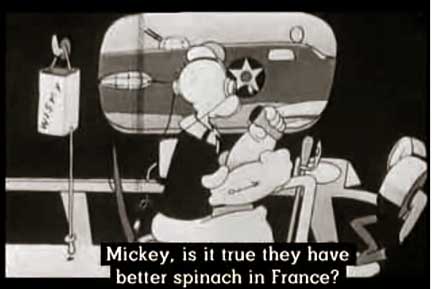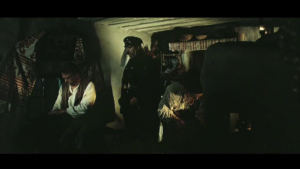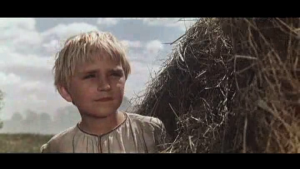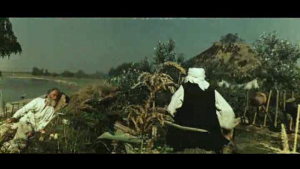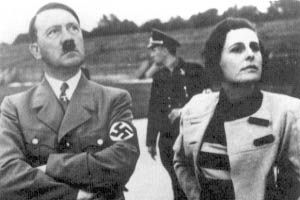This originally appeared in the June 24, 1994 issue of the Chicago Reader, with a slightly different title (“Can Film Be Fascist?”) —J.R.
** THE WONDERFUL HORRIBLE LIFE OF LENI RIEFENSTAHL
(Worth seeing)
Directed and written by Ray Muller.
*** THE EYE OF VICHY
(A must-see)
Directed by Claude Chabrol
Written by Jean-Pierre Azema and Robert O. Paxton.
Last year, about the time that Ray Muller’s mediocre if watchable three-hour documentary about Leni Riefenstahl was getting widespread coverage in New York, a European friend thoughtfully sent me a tape of Looking at “Triumph of the Will”, an excellent 45-minute BBC program designed to introduce Riefenstahl’s famous Nazi propaganda film to a contemporary audience. Interviewing such commentators as Hugh Hudson, Annette Insdorf, Claude Lanzmann, George Steiner, Hans-Jurgen Syberberg, Budd Schulberg, and Brian Winston, the program offered diverse historical, ideological, and aesthetic perspectives without privileging any single point of view. Riefenstahl herself refused to be interviewed, yet her own self-serving interpretation of her career was included, as well as that of one of her American apologists — David Hinton, the author of a book about her, who argues, as Riefenstahl does, that Triumph of the Will should not be regarded as propaganda.
A few vestiges of the more critical perspectives in that program are also available in Muller’s The Wonderful Horrible Life of Leni Riefenstahl, playing this week at the Music Box, but with a significant difference. Although the film itself, and the publicity and most of the press surrounding it, has tended to minimize this central fact, Muller’s documentary was made at Riefenstahl’s instigation, as a follow-up to her recently published autobiography, and she maintained veto rights over who could be interviewed in it. (Such rights obviously weren’t extended to her on the BBC program, which may be one reason she refused to cooperate.)
This isn’t to say that Muller’s documentary is simply a self-portrait. Given Riefenstahl’s controversial status, in Germany as well as other countries, it was no easy matter to find a director willing to make this film with her. Muller was reportedly chosen after 70 other filmmakers were considered, many of whom rejected the commission outright. Muller himself, who professes to have had an open mind on Riefenstahl, accepted the assignment but insisted on adding a few demurrals. One of them occurs roughly halfway through the film, when Riefenstahl’s angry denial that she ever hung out with Hitler and Goebbels (the latter her avowed archenemy) is immediately contradicted by quotations from Goebbels’s diary remarking on her presence at various social events.
It would be wrong, therefore, to insist that Muller’s documentary is simply a puff piece — that it’s like Stephen Schiff’s rhapsodic Riefenstahl profile in Vanity Fair a couple of years ago, or John Simon’s equally uncritical and unscholarly front-page review of the Riefenstahl autobiography in the New York Times Book Review last fall. But even with a running time of slightly over three hours, the film is far from the definitive, multifaceted portrait it aspires to be. Too many traces of Riefenstahl’s controlling hand remain, often in the film’s omissions. When Riefenstahl maintains at one point that Triumph of the Will is a “straight” documentary of a particular event, that would have been the perfect time for Muller to cite the film’s carefully crafted studio retakes well after the event, which were documented at some length in Albert Speer’s memoirs, among other places. Muller, apparently believing this fact to be less important than Riefenstahl’s social standing with Goebbels, lets the lie pass unchallenged.
Like Hitler himself in Triumph of the Will descending from the heavens, Riefenstahl is generally presented in this film as a fully formed deity, without family or ideology — merely as someone who worships beauty and strength. Unlike Hitler as we perceive him today, she’s also a survivor, a remarkable woman who continues to do dangerous deep-sea diving even in her 90s, and to extol the virtues of a pure art unsullied by history or politics. In her interviews with Muller, he may have the edge when it comes to matters of factual accuracy and political and historical correctness, but on issues of art and purity it’s Riefenstahl who often comes out ahead, if only because of her seniority and her unwavering protestations of innocence.
Toward the end of the film, when Muller asks her to define a fascist aesthetic and she replies that she doesn’t even know what the term means, she clearly has the audience on her side. And — notwithstanding all of Susan Sontag’s alluring arguments in the essay “Fascinating Fascism,” one of the better Riefenstahl hatchet jobs — it’s easy to understand her response. As Brian Winston put it on the BBC program, “I don’t think you can make a moral judgment about Riefenstahl’s work on the basis that it embodies fascist aesthetics, because I don’t think there’s any such thing. I think she stands in the mainstream of Western aesthetics, and I think that Western aesthetics can be, on occasion, fascist. That’s the problem with the whole phenomenon of fascism — that we want somehow to treat it as a virus. It isn’t; it’s part of us. It’s the dark side of the European tradition, and she represents that dark side perfectly.”
An even greater related problem is posed less by the film itself than by contemporary confusion — all of it to the advantage of Riefenstahl’s reputation — about the proper relation of art to politics. For months we’ve been reading that Riefenstahl is a great artist who has never received her due. This argument completely ignores the facts, to cite only two examples out of dozens, that her Triumph of the Will and Olympia (produced and financed by Goebbels’s ministry of propaganda) have been part of the permanent collection of New York’s Anthology Film Archives for well over a quarter of a century, a distinction not yet accorded to films by Fritz Lang, Kenji Mizoguchi, Michelangelo Antonioni, or Jean-Luc Godard, and that she was one of the first guests of honor to be saluted at the Telluride film festival.
The reasons for such myopia, I would argue, don’t really have much to do with Riefenstahl’s international standing as an artist. Rather, they have to do with a glaring contradiction in our notions about art and politics — a contradiction that Riefenstahl’s career throws into sharp relief. To put the matter crudely, we tend to celebrate artists who have absolute, dictatorial freedom and control over their resources, and condemn politicians who pursue or achieve the same aim.
It’s commonly believed that Riefenstahl is the only major woman director who dramatizes such a contradiction, but this isn’t the case. The other strong example is Yulia Solntseva, the widow of the great Russian filmmaker Alexander Dovzhenko. Starting out as an actress in her husband’s silent pictures, she later directed Stalinist and post-Stalinist films — including Poem of the Sea (1958), The Flaming Years (1961), The Enchanted Desna (1965), and Golden Gate (1969) — that are all eye-popping, ear-filling realizations of unfilmed Dovzhenko projects. The Enchanted Desna and Golden Gate are among the most ravishingly beautiful and poetic spectacles ever made, even if their ideological agendas consist largely of Stalinist claptrap. These movies used to be screened regularly in Paris, which is where I saw most of them, but they’re virtually unknown in this country, with the lamentable result that Riefenstahl is always treated in this neck of the woods as an exceptional case. But if I had to select a single totalitarian masterpiece to take with me to a desert island, I’d choose the spectacular 70-millimeter, stereophonic-sound Desna over Riefenstahl’s Olympia in a flash.
In the fourth episode of Godard’s video series Histoire(s) du cinema (showing at the Film Center this Sunday along with the third episode and Godard’s one-hour film JLG/JLG), Godard remarks, “[Director F.W.] Murnau and [cinematographer] Karl Freund invented Nuremberg lighting when Hitler still couldn’t afford a beer in a Munich cafe.” It’s one more blow against the received notion that Riefenstahl is somehow accountable for Nazi iconography. It’s worth adding that perhaps the most memorable uses of “Nuremberg lighting” in the United States during the same period were in Orson Welles’s antifascist stage version of Julius Caesar; he later adopted the same lighting schemes in his first feature. But if we’re talking about “pure” rather than applied aesthetics, the will to power that impresses us in Triumph of the Will and Olympia also impresses in Citizen Kane.
To put things crudely again, we are in awe of and infatuated with directors holding unlimited power. On the basis of Schindler’s List, Steven Spielberg was recently accorded the same puff-piece treatment by Stephen Schiff in Tina Brown’s New Yorker that Riefenstahl received from him in Tina Brown’s Vanity Fair. Ideologically speaking, the profiles are mirror images of each another. The fact that one director once promoted Nazism while the other is currently pushing capitalistic anti-Nazism (after exploiting Hitler as comic relief in Indiana Jones and the Last Crusade) is apparently secondary. The important fact is that Riefenstahl and Spielberg had big budgets at their disposal — oodles of extras, so to speak — and have commanded our adoration as artists largely for that reason.
In their indefatigable indifference to politics, undoubtedly inspired by a desire to remain “pure” artists, Riefenstahl and Spielberg have something else besides huge budgets and cheering sections in common. But if you want to learn something about these filmmakers’ subjects, Triumph of the Will and Schindler’s List are just about the worst possible places to look — though they do offer indirect insights on the mind-sets of their contemporary audiences. The Wonderful Horrible Life of Leni Riefenstahl has the advantage of Muller’s skeptical asides, but not much more. (The stupid title, incidentally, shouldn’t be blamed on Muller — the original title translates as “Leni Riefenstahl: The Power of Images” — but on the individual at England’s Channel Four who decided that something racier was needed for the Anglo-American market.)
To learn something about Nazism and World War II, you’d be much better off going to see Claude Chabrol’s The Eye of Vichy, receiving its last two screenings this Sunday at Facets Multimedia (unfortunately overlapping with the Film Center’s Godard program). As an early title in Chabrol’s documentary explains, this compilation of French newsreels and related archival footage shows France between 1940 and 1944 “not as it was, but as Petain and his collaborators wanted it to be seen.” Consequently the film gives us some notion of what it was like to be living in France during the German occupation — or at least what it was like to see newsreels there and then. Occasional voice-overs briefly interject information that the newsreels either omitted or obscured.
Though the materials on view in The Eye of Vichy lack the enticement of Riefenstahl’s glamour, as a movie star or as an all-powerful, artful director, they’re fascinating simply because they tell us about the past. Whatever once qualified as sugarcoating comes across today as camp or simple deceit, and through all the lies we can readily discern the intricate rationalizations of a defeated country’s propagandists telling its citizens not to worry.
Chabrol’s caustic irony and humor can often be felt behind his editing choices. In 1941 the unemployed French populace are encouraged to find work in Germany; postmen are seen selling Marshal Petain’s portrait from door to door, reportedly in order to feed the hungry; a tasty bit of agitprop called “The Jewish Peril” employs Eisensteinian montage to show the relationship between Jewish families and hordes of rats, while a glimpsed poster proclaims “How to Tell a Jew From a Frenchman”; there are comments on the communist menace that anticipate 50s America; and a newsreel story about the trashing and recycling of old movie film explains “how your favorite film star may now be used to varnish your nails.”
In 1942 a similar story about sweaters made out of human hair refers not to the recycling of Jewish corpses but to the happy sacrifices French people are making for the war effort (though the Nazi implications are hard to shake off). Another jokey item informs us that it’s “right” for a clochard in the park to be collecting cigarette butts for his pipe tobacco because tobacco is in short supply, but “wrong” because discarded cigarette butts are bad for one’s health. The materials for this year conclude with Petain’s Christmas message.
In 1943 we get a newsreel flashback to a Nazi rally in 1933 (“a historic date in the life of Europe”), tips on saving gas, glimpses of trailers for forgotten films, more jeremiads against the threat of civil war and communist “barbarism,” and another Christmas message from Petain. In 1944 a detailed look at the decreases in French unemployment since 1940 is succeeded by a delirious cartoon that shows Popeye, Mickey Mouse, and Donald Duck piloting Anglo-American bombers, about to kill innocent French citizens. Finally, after glimpses of the last occupation newsreel, Chabrol treats us to images of the liberation of Paris — including a shot or two familiar from the French newsreels in Edgardo Cozarinsky’s masterful compilation One Man’s War — and the information that, after being forbidden for four years, public dances were given again.
It’s important to bear in mind that French newsreels between 1940 and 1944 are a close equivalent of TV news programs today, and that both are close equivalents of propaganda and advertising; how we differentiate between the four forms of communication is more a matter of degree and context than of substance. As Hugh Hudson rightly points out in the BBC documentary, Triumph of the Will was essentially “an advertising film,” and if we consider the image of Germany that Olympia — the greatest sports documentary ever made — was meant to promote, that film may not be far behind. We might also describe The Wonderful Horrible Life of Leni Riefenstahl, The Eye of Vichy, the period clips in both, CNN and CBS and ABC and NBC as advertising or propaganda; the differences between them, when they matter, lie strictly in what’s being sold.


